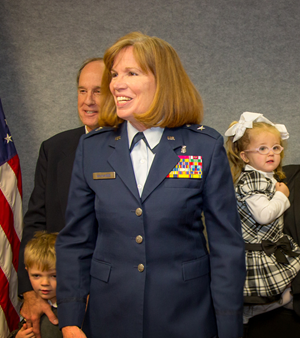Story by: 2nd Lt. Phil Fountain
Post: Jan 23, 2015
149th Fighter Wing Public Affairs
 AUSTIN, Texas (Jan. 23, 2015) – In one of his last official acts, former Gov. Rick Perry commissioned the first female Texas Air National Guard officer as a brevet brigadier general, in Austin, Texas, effective Dec. 31, 2014.
AUSTIN, Texas (Jan. 23, 2015) – In one of his last official acts, former Gov. Rick Perry commissioned the first female Texas Air National Guard officer as a brevet brigadier general, in Austin, Texas, effective Dec. 31, 2014.
Retired Col. Constance C. McNabb of Montgomery, Texas was presented with the general officer commission by Maj. Gen. Kenneth W. Wisian, Deputy Adjutant General for Air and Commander of the Texas Air National Guard, in a ceremony at Camp Mabry, in Austin, Texas, Jan. 23, 2015.
“This is a real thrill to recognize Connie with the brevet brigadier general,” said Wisian. “This is overdue recognition for under-heralded work.”
McNabb retired after more than 23 years of service as a member of the U.S. Air Force, Nebraska Air National Guard and Texas Air National Guard.
She was first commissioned as a captain in the U.S. Air Force’s Biomedical Science Corps. A “Citizen-Airman,” McNabb is also a Texas licensed, graduate veterinarian.
McNabb served a varied military career that included service as commander of the 149th Medical Group, a subordinate unit of the 149th Fighter Wing, based at Joint Base San Antonio-Lackland, Texas, TXMF Joint Surgeon then Chief of the Joint Staff for the Texas Military Forces, at Camp Mabry.
Her career culminated with her service as the Air National Guard Assistant to the Surgeon General at Headquarters, 25th Air Force at JBSA-Lackland.
“I look forward to seeing you around here more in the future and continuing to be a mover and shaker within Texas,” Wisian said. “Hopefully, broader than just within the Texas Military Forces.”
The Texas Government Code authorizes the governor, upon recommendation of the adjutant general, to confer a brevet commission “for gallant conduct or meritorious military service.” The code allows for the governor to commission the officer to the next higher grade.
In McNabb’s case, she was promoted from the rank of colonel to brigadier general in the National Guard of the State of Texas.
The military brevet is a significant state honor that's been bestowed upon only a few members of the Guard.
During his time in office, Perry issued only six brevets to active service members, according to the Texas Military Forces General Officer Management Office. McNabb is the first female from the Texas Air Guard.
The significance of her service was described in her recommendation for this honor.
“Colonel Constance C. McNabb distinguished herself by exceptionally meritorious performance of duty in a succession of positions of increasing responsibility,” wrote Maj. Gen. John F. Nichols, the 51st Adjutant General of Texas, to the governor in his recommendation. “In each duty assignment, Colonel McNabb’s exceptional leadership skills, personal and professional relationships and dedication to mission accomplishment were apparent throughout her military career in the Texas Air National Guard.”
McNabb expressed humility to receive this honor.
“This is far more than I ever expected,” she said. “[It’s] an honor I never expected and for which I am most grateful.”
“Humbled, thankful and appreciating the leadership of Gov. Rick Perry, Maj. Gen. John Nichols and Maj. Gen. Kenneth Wisian,” McNabb said after receiving the commission.
Brevet Brig. Gen. McNabb is not resting on her laurels.
She said she is looking forward to continuing her service to the state of Texas as a member of the Texas State Guard, the volunteer component of the Texas Military Forces.
Additionally, McNabb said she is excited to be enrolled in a graduate program at Texas A&M University’s Bush School of Government and Public Service, where she is seeking a graduate certificate in non-profit management.
She said she’s not sure what else the future might bring, but she will seek opportunities to serve Texas and her fellow veterans.
“It’s been a wonderful ride,” McNabb said. “And I look forward to the opportunity to continuing to serve the Texas Military Forces.”